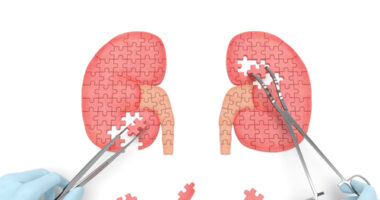COL4A5 Mutation Tied to XLAS Does Not Cause Disease, Study Suggests

A given mutation in the COL4A5 gene — the gene involved in X-linked Alport syndrome — is likely not a disease-causing (pathogenic) defect although it has been identified as such, a study from China reports.
Its researchers suggest that the presence of this mutation, called c.2858G>T and common to people of Asian heritage, should not be the sole basis for diagnosing X-linked Alport syndrome. Rather, other disease symptoms should also be evident.
Their study, “Reassessing the pathogenicity of c.2858G>T(p.(G953V)) in COL4A5 Gene: report of 19 Chinese families,” was published in the European Journal of Human Genetics.
Alport syndrome is caused by mutations in the COL4A3, COL4A4, and COL4A5 genes, leading to defects in a major structural protein called type 4 collagen. This protein acts like a barrier between tissue compartments and is essential for the normal functioning of the kidney, inner ear, and eye.
While all Alport patients develop progressive kidney disease, some will also have hearing loss and vision problems. Kidney damage is typically evident in the form of hematuria (blood in the urine), proteinuria (proteins in the urine), and changes in the glomerular basement membrane (GBM), which has a key role in the kidney’s filtration barrier.
Between 80% and 85% of patients have the X-linked form of the disease, meaning they inherited a mutation in the COL4A5 gene located on the X chromosome — one of the two sex chromosomes (X and Y) passed to a child from their parents.
Because males have only one X chromosome, X-linked Alport syndrome (XLAS) is more severe in men than in women, who have two X chromosomes.
To date, 1,000 mutations in COL4A5 have been reported, but limited evidence supports the disease-causative nature for many of them.
The c.2858G>T mutation in the COL4A5 gene has been considered disease causing due to the likely structural change it causes in type 4 collagen. However, this mutation has only been reported in four Alport patients, and in all of them, additional pathogenic mutations in the COL4A5 or COL4A4 genes were also detected.
The relatively high frequency of this mutation in the Asian population also suggests it may not be disease causing.
To clarify this, researchers in Beijing analyzed the genetic and clinical data of 19 Chinese families (51 people) carrying the c.2858G>T mutation; their genetical data was obtained through next-generation sequencing (NGS).
The families were selected from the online registry database of hereditary kidney diseases in children in China.
NGS, a widely applied method that allows comprehensive genetic screening for mutations, has shown advantages to conventional Sanger sequencing in people who might have Alport syndrome.
A total of 36 people within these 19 families carried the c.2858G>T mutation, including 18 children.
The families were divided into three groups based on the children’s genetic data: those with additional disease-linked mutations in other genes (seven families; data on six children and a mother); those with an additional pathogenic mutation in the COL4A5 gene (six families); and those with only a c.2858G>T mutation (six families).
Children carrying additional pathogenic mutations in other genes and those with only c.2858G>T mainly had early onset of kidney failure or nephrotic syndrome, but no clinical features characteristic of Alport syndrome, results showed.
Most families in these two groups had no prior history of hematuria, no hearing or vision problems, and 11 family members (nine women and two men) carrying only the c.2858G>T mutation were asymptomatic.
Six children carrying another pathogenic mutation in the COL4A5 gene showed symptoms consistent with a XLAS diagnosis. All had hematuria and proteinuria, a kidney biopsy done in five children showed GBM abnormalities in four of them, and one developed hearing loss.
“We conclude c.2858G>T(p.(G953V)) in COL4A5 gene is not a pathogenic variant for XLAS,” the researchers wrote.
They suggested that the presence of family history of Alport syndrome or kidney failure, hearing loss, vision problems, changes in the GBM, or detection of abnormal collagen 4 may help avoid a misdiagnosis of XLAS in people with only one COL4A5 mutation.
The team noted, however, that future studies are required to determine whether the presence of the c.2858G>T mutation in the COL4A5 gene may modify aspects of the disease.







Leave a comment
Fill in the required fields to post. Your email address will not be published.